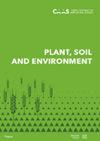葡萄藤叶片电离层受土壤因素和植株年龄的影响
IF 1.8
3区 农林科学
Q1 AGRONOMY
引用次数: 0
摘要
风土的概念将葡萄酒的感官属性与葡萄树的环境条件联系起来,因此它代表了葡萄酒与其原产地之间联系的重要描述。在不断努力改进葡萄产品的监测和地球化学指纹图谱的过程中,了解葡萄元素组成的可变性,以及对这种可变性有强烈影响的因素,可以显著提高葡萄酒对其原产地的可追溯性。在这里,我们证明了葡萄元素组成与单个葡萄园的微位置有很强的联系,其中生物土壤因素有重要贡献。在测量叶片元素的差异似乎更密切地联系到葡萄树的年龄,而不是葡萄栽培实践(生物vs.传统)。土壤微生物群落对葡萄叶片元素有重大影响,真菌和细菌之间存在差异。细菌似乎比真菌与葡萄园环境的关系更密切,它们相互作用的变化反映在葡萄藤的元素组成上。然而,这两种微生物群体解释了葡萄叶片元素变化的15%至17%,使土壤真菌和细菌群落成为风土概念中的关键因素。本文章由计算机程序翻译,如有差异,请以英文原文为准。
Grapevine leaf ionome is shaped by soil factors and plant age
The concept of terroir relates the sensory attributes of wines attributable to the environmental conditions of the grapevines, and therefore it represents an important descriptor of the connection between wines and their origins. In ongoing efforts to improve the monitoring and geochemical fingerprinting of grapevine products, knowledge of the variability of grapevine elemental compositions, and factors that have strong influences on this, can significantly improve the traceability of wines to their origins. Here, we demonstrate a strong connection of grapevine elemental composition to the micro-location of the individual vineyard, with an important contribution from the biotic soil factors. The differences in measured leaf elements appear to be more closely connected to the grapevine age than to the viticultural practice (biological vs. conventional). Soil microbial communities have a substantial impact on grapevine leaf elements, with differences seen between fungi and bacteria. Bacteria appear to be more closely related to the environment in vineyards than fungi, with changes in their interplay reflected in the elemental composition of the grapevines. Nevertheless, both microbial groups explain 15% to 17% of the variation in the grapevine leaf elements, making the soil fungal and bacterial communities critical factors in the terroir concept.
求助全文
通过发布文献求助,成功后即可免费获取论文全文。
去求助
来源期刊

Plant, Soil and Environment
Agronomy, Soil Science-农艺学
CiteScore
4.80
自引率
4.20%
发文量
61
审稿时长
2.4 months
期刊介绍:
Experimental biology, agronomy, natural resources, and the environment; plant development, growth and productivity, breeding and seed production, growing of crops and their quality, soil care, conservation and productivity; agriculture and environment interactions from the perspective of sustainable development. Articles are published in English.
 求助内容:
求助内容: 应助结果提醒方式:
应助结果提醒方式:


